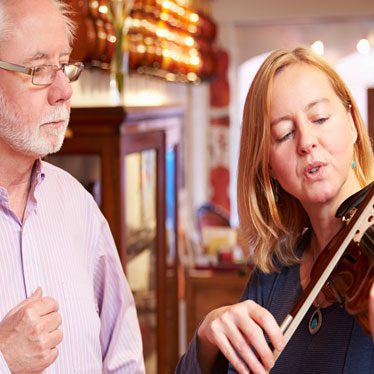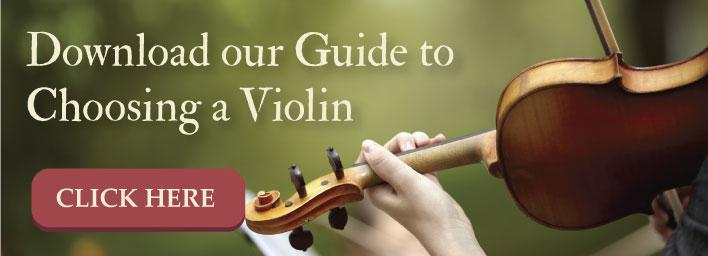Everything You Need to Know About Buying a Violin

If you’ve recently made the decision to purchase a violin, you may feel a bit daunted by the general lack of guidelines available. Violins come in so many different price ranges and qualities that just knowing how much your budget will permit does little for aiding your choice. Obviously, you’ll want to get the best quality instrument for the best possible price. So, before you start shopping, there are a few things to keep in mind when buying a violin.
The Basics
Whether a student is starting with the most basic of violins or looking for a fine quality instrument, there are a few points that are an absolute must:
A violin must be well constructed and durable. The pegs must operate smoothly so that the instrument can be tuned to pitch and remain in tune. The bridge must be properly fitted so that correct spacing and heights between the strings allows the bow to move from one string to the next easily. The fingerboard and nut must be dimensioned and shaped so that the violin will not buzz as it is being played. The sound post should be fitted to bring forth the best possible sound from the violin. Even the lowest cost instrument that a student should consider will possess these basics, along with good strings and quality fittings.
The best sounding violins are constructed of aged wood coupled with premium finishes and will vary in price depending on the quality of these components and the degree of care taken to fabricate and finish the instrument. As a rule of thumb,, if you’re looking for a good quality student or beginner violin, the prices range between a few hundred to a few thousand dollars.
The artisans who make stringed instruments, like the violin, are called luthiers, and the craftsmanship involved in the process helps determine the instrument’s worth. Indeed, there are many modern luthiers who make exceptional instruments, such as Tennessee Luthier Keith Williams, who yearly shows off his skills and instruments at the Dollywood Theme Park each October. His advice: “the biggest thing to look for is the craftsmanship… that the workmanship is neat.”
Inferior instruments are made from some combination of wood that hasn’t been properly seasoned, with poor quality fittings and strings, or with sub-par set-up (such as poorly fitting pegs, misshapen fingerboards or incorrectly cut bridges) so that the instrument doesn’t function properly.
The top of the violin is typically made from Spruce, which is a wonderful tone-wood for violins because its light-weight strength generates excellent resonance (vibration).
Maple is used for the back, sides, and necks of violins. Other types of wood will help dictate the price of the violin, such as ebony for the pegs and chin rest; but it’s a good idea determine at least on Maple as other inferior woods will negatively affect the sound, durability, and performance of the instrument.
Mr. Williams explained it like this, “all of the wood used [to create] the body reflects the vibrations from the top.” Curly Maple is his choice, combined with European Red Spruce.
Construction
A good quality violin will have been constructed by an experienced luthier or the staff of a well-trained factory and set-up by an experienced luthier. The construction of the violin has a significant impact on the sounds that are generated by it, and how easy it is to play.
Here are some important things you can check to determine the quality of a violin’s construction.
Look for:
- Absolutely no creaking sounds when gentle pressure is applied to any part of the body of the violin.
- A visible Sound Post, is basically a wedged dowel piece of spruce wood inside the body of the violin, about 1/4” in diameter, cut on an angle to match the top and bottom insides of the violin. It is designed to increase the pressure of the top to enhance the resonate quality of the violin. If you can’t see it through one of the F hole slots the sound post may have shifted. This will require an experienced luthier to re-seat it.
- Visually inspect the violin for any warping, cracks, or other structural defects.
- Mr. Williams explained that when buying a violin, “also look at the perfling [inferior instruments] have them drawn on” rather than inlaid.
Sizes
Violins come in seven different sizes. Adults will play a 4/4 size violin. Very young learners may choose a ½ or ¾ size violin as their first instrument.
You can measure the size violin you need by placing the violin between your jawbone and left shoulder, as if you were about to play it, and extending your left arm out from your body, palm up. If you can easily curl your fingers around the Scroll, you’ve found the perfect fit. Likewise, if it’s too hard to reach your fingertips to the Scroll Box, the violin is too big; and if you have to bend your arm to perform the action, the instrument is too small.
Outfits
Until recently, the availability of a quality outfit for violin purchasing including a fine quality bow, violin case, and associated accessories was practically non-existent. However, there are now some very fine quality outfits available for beginner and intermediate violinists.
Other Great Tips to Use when Buying a Violin
- If you can, take a trusted friend or your teacher with you when you make the purchase. It’s always good to have an extra set of ears and eyes when buying a violin.
- Play it before you buy it. In making your final selection among several well-made violins. Sound quality and how easy the instrument feels to play are what’s most important.
- The set-up process is crucial. Make sure that your instrument has been set-up by a luthier before you buy it.
- Consider the accessories you’ll need if this is a first-time purchase. Bow, case, cleaning materials, a music stand, and strings are important, but also if you live in an extremely dry climate, you might want to consider a humidifier to prevent tone wood damage.
- Keith Williams’ advice, “Look for a label inside.”
You’re making an important investment, and the quality of the violin you choose will determine how enjoyable it is to play. Take your time, get good advice, and choose wisely.


